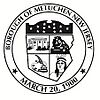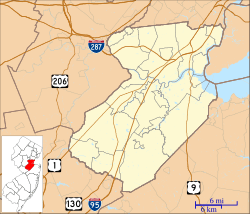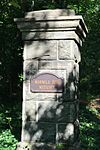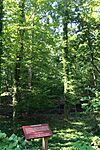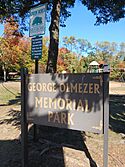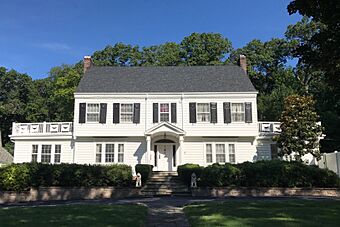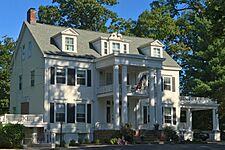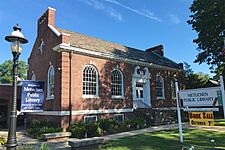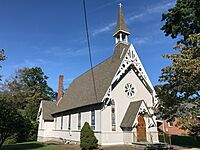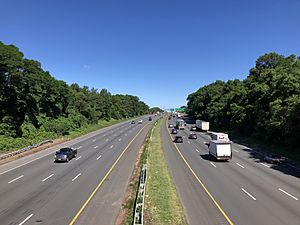Metuchen, New Jersey facts for kids
Quick facts for kids
Metuchen, New Jersey
|
||
|---|---|---|
|
Borough
|
||
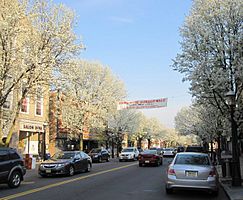
Main Street in downtown Metuchen, which won the honor of Great American Main Street of the Year in 2023
|
||
|
||
| Nickname(s):
The Historic Brainy Borough
|
||

Location of Metuchen in Middlesex County highlighted in red (left). Inset map: Location of Middlesex County in New Jersey highlighted in orange (right).
|
||
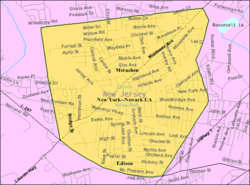
Census Bureau map of Metuchen, New Jersey
|
||
| Country | ||
| State | ||
| County | Middlesex | |
| Incorporated | March 20, 1900 | |
| Government | ||
| • Type | Borough | |
| • Body | Borough Council | |
| Area | ||
| • Total | 2.84 sq mi (7.36 km2) | |
| • Land | 2.84 sq mi (7.35 km2) | |
| • Water | 0.00 sq mi (0.01 km2) 0.07% | |
| Area rank | 348th of 565 in state 18th of 25 in county |
|
| Elevation | 95 ft (29 m) | |
| Population
(2020)
|
||
| • Total | 15,049 | |
| • Estimate
(2023)
|
14,977 | |
| • Rank | 175th of 565 in state 17th of 25 in county |
|
| • Density | 5,282.2/sq mi (2,039.5/km2) | |
| • Density rank | 105th of 565 in state 9th of 25 in county |
|
| Time zone | UTC−05:00 (Eastern (EST)) | |
| • Summer (DST) | UTC−04:00 (Eastern (EDT)) | |
| ZIP Code |
08840
|
|
| Area code(s) | 732 | |
| FIPS code | 3402145690 | |
| GNIS feature ID | 0885298 | |
Metuchen (/məˈtʌtʃən/ mə-TUTCH-ən) is a town called a borough in Middlesex County, New Jersey. It's a commuter town for New York City. This means many people who live here travel to New York for work. Metuchen is in the middle of the Raritan Valley region.
The borough is a busy center for business in Central New Jersey. It's right next to Edison, which completely surrounds it. Metuchen is about 6 miles (10 km) northeast of New Brunswick. It's also about 22 miles (35 km) southwest of Manhattan. In 2020, about 15,049 people lived in Metuchen. This was a jump of over 1,400 people since 2010.
Metuchen became an official borough on March 20, 1900. This happened through a law passed by the New Jersey Legislature. In 2023, Metuchen's Main Street won a big award. It was named Great American Main Street of the Year.
Contents
Exploring Metuchen's Past
The first people to live in this area were the Raritan people. They were part of the Lenape Native American tribe. They lived here and traveled to the coast. In 1646, a chief named Matouchin led a group of 1,200 warriors.
Before 1870, Metuchen was part of Woodbridge Township. People in the western part of the township felt different. They were far from the main Woodbridge settlement. The name "Metuchen" first appeared around 1688. It came from a Native American chief named Matouchin or Matochshegan. In 1701, someone was put in charge of roads for the "Metuchen district."
A meeting house was built between 1717 and 1730. It was for weekday meetings of the Woodbridge Presbyterian Church. By 1756, Metuchen Presbyterians had enough people to form their own church. The two churches joined in 1770, then separated again in 1793.
Metuchen didn't change much from the late 1700s to the early 1800s. A map from 1799 showed only ten buildings on Main Street. By 1834, there was a church, a store, two taverns, and about a dozen homes. New roads built in 1806 and 1808 didn't make the town grow much. Growth really started with the arrival of the railroad.
The Railroad Era and Growth
In 1836, the New Jersey Railroad reached New Brunswick. A train station was built on Main Street in Metuchen. This made Main Street the most important street. Soon, businesses started to appear near the railroad tracks. Old taverns were replaced by hotels.
The second half of the 1800s brought many changes to Metuchen. New churches were started, including the Reformed Church and St. Luke's Episcopal Church. The first Catholic mass was also held. In 1870, a building and loan association and a library opened. That same year, Raritan Township was formed. Metuchen was the biggest village in this new township. It became the main center for business and culture.
In 1873, the town hosted the Rutgers College Glee Club. They performed their school song for the first time ever. By 1882, Metuchen School #15 had 256 students. In 1885, a local newspaper listed 37 businesses.
The 1890s saw many new services come to Metuchen. Telegraph service began in 1894. Telephone service started in 1897. The Midland Water Company began providing water for fire hydrants. A new street lighting system was put in place in 1899. Trolley service started in 1900. By 1899, there were 91 businesses listed in the New Brunswick Directory.
Many artists, writers, and smart people moved to Metuchen during this time. This led to the town's nickname: "the Brainy Boro." One of Metuchen's post offices is even called Brainy Boro Station. The borough officially became a town in 1900.
In 1981, Metuchen became the main city for the new Roman Catholic Diocese of Metuchen. This diocese serves over 500,000 Catholics in four counties. The Metuchen Borough Hall was built in 2005. From 1948 to 2004, the Ford Motor Company made millions of cars at a factory nearby. It was called Edison Assembly, but was named for Metuchen until 1980.
In 2022, Metuchen was a finalist for the 2023 Great American Main Street Award. They later won the award! The 2023 "Girl of the Year" doll from American Girl, Kavi Sharma, is from Metuchen. She is the first doll of South Asian background. In April 2024, Money Magazine called Metuchen the best place to live in New Jersey. They also said it was one of the best places in the whole country.
Metuchen's Location
Metuchen covers about 2.85 square miles (7.39 km2). Most of this is land, with a tiny bit of water.
The Borough of Metuchen is completely surrounded by Edison. This makes it one of 21 "doughnut towns" in New Jersey. A doughnut town is when one town completely wraps around another.
Metuchen has been called a "town center" since 1996. It's also been a "transit village" since 2001. This means it's recognized for smart growth. There are plans to build new homes and shops near the train station.
Metuchen's People
| Historical population | |||
|---|---|---|---|
| Census | Pop. | %± | |
| 1890 | 770 | — | |
| 1900 | 770 | 0.0% | |
| 1910 | 2,138 | 177.7% | |
| 1920 | 3,334 | 55.9% | |
| 1930 | 5,748 | 72.4% | |
| 1940 | 6,557 | 14.1% | |
| 1950 | 9,879 | 50.7% | |
| 1960 | 14,041 | 42.1% | |
| 1970 | 16,031 | 14.2% | |
| 1980 | 13,762 | −14.2% | |
| 1990 | 12,804 | −7.0% | |
| 2000 | 12,840 | 0.3% | |
| 2010 | 13,574 | 5.7% | |
| 2020 | 15,049 | 10.9% | |
| 2023 (est.) | 14,977 | 10.3% | |
| Population sources: 1890 1900–1920 1900–1910 1910–1930 1940–2000 2000 2010 2020 |
|||
In 2020, the 2020 United States census counted 15,049 people living in Metuchen. There were 5,255 households. About 26% of households had children under 18. Most households (65.6%) were married couples.
The average household had 2.83 people. The average family had 3.35 people. The average income for a household was about $141,915. For families, it was about $163,438. Only a small number of families (1.7%) lived below the poverty line.
Parks and Fun Places
Metuchen has many public spaces for everyone to enjoy. These include parks, historical sites, and a war memorial.
The Middlesex Greenway is a 3.5-mile (5.6 km) paved path. You can bike or walk on it. It connects Metuchen to Woodbridge Township. It's also part of the larger East Coast Greenway.
Centennial Park is Metuchen's biggest park. It covers 13 acres (5.3 hectares). You can find it off Grove Avenue. The park has Beacon Hill, which is the highest spot in the borough at 169 feet (52 m).
Woodwild Park is a 3.5-acre (1.4 hectare) park. It's a natural area managed by the Woodwild Park Association. It's part of the Middlesex Avenue–Woodwild Park Historic District. This district was added to the National Register of Historic Places in 2017.
George Olmezer Memorial Park is named after a former councilman. It was created in 1982.
Metuchen Memorial Park is a war memorial. It was started in 1925 to honor those who served in World War I. It has been updated to honor all Metuchen residents who served in wars. The town's yearly Memorial Day Parade ends at this park.
Tommy's Pond is on a 1.8-acre (0.73 hectare) site. The pond itself is 0.4 acres (0.16 hectares). It's used for an annual fishing derby. In the past, people used to go ice skating there in winter.
The Dismal Swamp is a natural area nearby. It's sometimes called the "Everglades of Central New Jersey."
Schools in Metuchen
Public Schools
The Metuchen School District teaches students from pre-kindergarten all the way through twelfth grade. In the 2019–20 school year, the district had about 2,300 students. There are four schools in the district:
- Mildred B. Moss Elementary School (Pre-K and Kindergarten)
- Campbell Elementary School (grades 1–4)
- Edgar Middle School (grades 5–8)
- Metuchen High School (grades 9–12)
Students in eighth grade from all of Middlesex County can apply to special high school programs. These are offered by the Middlesex County Vocational and Technical Schools. They teach career and technical skills. There is no tuition fee for students to attend.
There have been two historical schools named after Benjamin Franklin. The Old Franklin Schoolhouse was a one-room school. It was built in 1807 and used until 1870. Today, it's a place for community music events. It's also a historic site. A larger Franklin School was built in 1909. It was torn down in 1999 to build new homes.
Private Schools
Metuchen is home to St. Joseph High School. This is a private Catholic school for boys. It's known for its strong academics and sports. Saint Francis Cathedral School is a Pre-K to 8th grade school. In 2017, it was named an "Exemplary High Performing School." This is a special award from the United States Department of Education.
Historic Places to See
The Middlesex Avenue–Woodwild Park Historic District is a special area in Metuchen. It has many old buildings and sites that are important to history. It was added to the National Register of Historic Places in 2017. This district includes 197 important buildings.
Getting Around Metuchen
By the early 1900s, many Metuchen residents traveled for work. About 400 people commuted daily out of a population of 1,786. Being close to New York City and New Brunswick made Metuchen a popular place to live. It was seen as a quiet, small town where people could escape the busy city.
Roads and Highways
As of 2010, Metuchen had about 47 miles (76 km) of roads. Most of these were maintained by the town itself.
Cars changed Metuchen a lot between World War I and World War II. Gas stations were built in the 1920s. When U.S. Route 1 was built in 1930, it took traffic away from Middlesex Avenue. This helped Metuchen stay a quiet residential town.
Both Route 27 and CR 531 go through Metuchen. They meet in the center of town. Interstate 287 runs along the southern edge of the borough. Other major roads like the New Jersey Turnpike (Interstate 95) and the Garden State Parkway are also nearby.
Public Transportation
The Metuchen station offers train service. You can take NJ Transit's Northeast Corridor Line to many places. These include the Trenton Transit Center and New York Penn Station.
NJ Transit also has local bus service. You can catch buses on the 810, 813, and 819 routes.
Famous People from Metuchen
Many interesting people have lived in or are connected to Metuchen. Here are a few:
- Marqus Blakely (born 1988), a basketball player who won awards.
- Charles Brown (1946–2004), an actor.
- Barbara Buono (born 1953), a former New Jersey State Senator.
- John Ciardi (1916–1986), a poet.
- David Copperfield (born 1956), a famous magician.
- Paula Danziger (1944–2004), a children's author who wrote over 30 books.
- Bernard J. Dwyer (1921–1998), a politician who served in the U.S. House of Representatives.
- Gail Fisher (1935–2000), the first Black actress to win an Emmy Award.
- James Florio (1937-2022), a former Governor of New Jersey.
- Mary Eleanor Wilkins Freeman (1852–1930), an author and novelist.
- Robert Hegyes (1951–2012), an actor known for Welcome Back, Kotter.
- Cecelia Holland (born 1943), a historical novelist.
- Elie Honig (born 1977), an attorney and legal expert for CNN.
- Robert Kaplow (born c. 1954), a teacher and novelist. His book was made into the movie Me and Orson Welles.
- Jerome H. Lemelson (1923–1997), an inventor with over 550 patents.
- Lonny Price (born 1959), an actor, writer, and director.
- Thomas Mundy Peterson (1824–1904), the first African-American to vote in an election in the U.S.
- Brian Ralph (born 1973), a cartoonist. His graphic novel Daybreak became a Netflix series.
- Tom Ruegger (born 1955/1956), an animator who created Animaniacs.
- Quinn Shephard (born 1995), an actress, writer, and director. Her first film, Blame, was filmed in Metuchen.
- Robert Taub (born 1955), a concert pianist.
- Marvin Webster (1952–2009), a former professional basketball player for the New York Knicks.
- Richard Wenk (born 1956), a screenwriter and director.
- Julian E. Zelizer (born 1969), a professor of political history at Princeton University.
See also
 In Spanish: Metuchen para niños
In Spanish: Metuchen para niños


